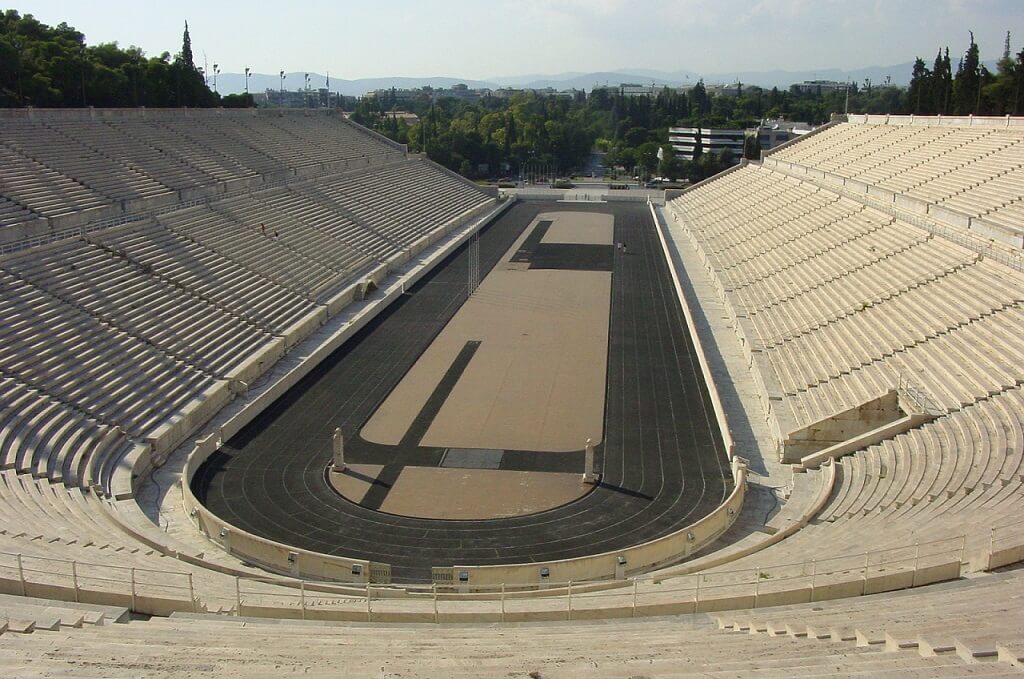
Panathenaic Stadium (Kallimarmaro)

Brief Overview
The Panathenaic Stadium, also known as the Kallimarmaro (meaning the "beautifully marbled"), is a multi-purpose stadium used for several events and athletics in Athens.
The Stadium hosted the first modern Olympic Games in 1896. Reconstructed from the remains of an ancient Greek stadium, the Panathenaic is the only stadium in the world built entirely by marble (from Mount Penteli) and is one of the oldest in the world.
History
In ancient times, the stadium on this site was used to host the athletic portion of the Panathenaic Games, in honor of the Goddess Athena. During classical times, it had wooden seating.
In 329 BC it was rebuilt in marble by the archon Lycurgus and in 140 AD was enlarged and renovated by Herodes Atticus, giving a seated capacity of 50,000.
The remnants of the ancient structure were excavated and refurbished, with funds provided by Evangelis Zappas, for the revival of the Olympic Games. Zappas sponsored the Olympic Games that were held there in 1870 and 1875.
In 1895 the stadium was refurbished a second time for the 1896 Olympics, with completion funding provided by the Greek benefactor George Averoff, whose marble statue now stands at the entrance, based on designs by the architects Anastasios Metaxas and Ernst Ziller.
In 1906 the Panathenaic Stadium hosted another one major international athletic event the 1906 Intercalated Games.
On April 4, 1968, the 1967-68 FIBA European Cup Winner's Cup final was hosted in the stadium where AEK Athens defeated Slavia Prague in front of around 80,000 seated spectators inside the arena and another 40,000 standing spectators.
It is believed that since that game the Panathenaic Stadium holds the world record attendance for any basketball game to date.
In the 2004 Olympic Games, the Panathenaic Stadium hosted the archery competition and the finish of the Marathon.

In Detail
The Panathenaic Stadium is located on the site of an ancient stadium and for many centuries hosted games in which nude male athletes competed (gymnikoi agones) in track events, athletics championships as we would call them today. The games, which since antiquity had been held in an area far from the city, were included in the programme of the Panathenaia festival celebrations in 566/565 BC. When the orator Lykourgos assumed responsibility for the finances of Athens, in 338 BC, he included in the public works carried out in the city the building of a Stadium. The ravine running between Ardettos Hill and the low height opposite, extra muros of the city and in an idyllic setting on the verdant banks of the River Ilissos, was deemed to be an ideal location. This was private land but its owner, Deinias, conceded it to the State for the construction of a Stadium. Major earth-removal works transformed the ravine into a space for contests, with the features of the Greek stadium: parallelogram shape with entrance at one narrow end and room for the spectators on the earth slopes of the other three sides. Lykourgos' stadium was used for the first time during the celebration of the Great Panathenaia in 330/29 BC, when games in which nude athletes competed were held.
In Roman times the city of Athens was no longer a political power. However, it enjoyed a new intellectual and artistic heyday in the reign of Emperor Hadrian, between AD 117 and 138. In this period, the orator and sophist Herodes son of Atticus spent part of his vast fortune on erecting splendid buildings in many sanctuaries and cities of the Roman Empire. Thanks to the generosity of Herodes, significant works were carried out in the Stadium between AD 139 and 144, which resulted in two main changes to the initial form: the conversion of the original rectilinear shape to horseshoe shape by adding the sphendone, characteristic form of Greek stadia in Roman times, and the installation in the space for spectators, the theatron, of rows of seats (edolia) of white Pentelic marble. A vaulted passage under the east retaining wall terminated at the back of the Stadium. On the track (stibos), marble slabs demarcated the starting line (aphesis) and the finishing line (terma). Integral elements of the track were the bifacial herms. The entrance acquired a propylon in the Corinthian order. A triple-arched marble bridge spanning the Ilissos secured easy access to the Stadium from the city. The whole space, and primarily the portico at the level of the sphendone, was adorned with statues of marble, bronze and even gold. The temple of the goddess Tyche/Fortuna, housing the ivory cult statue of the goddess, had been built on the summit of Ardettos. The Athenians were justly proud of the Panathenaic Stadium, which was unrivalled in the world. For many years, the tomb of Herodes dominated the hilltop left of the entrance.
With the prevailing of Christianity and the prohibiting of pagan celebrations and the barbarous spectacles of Roman times, such as bloody gladiatorial duels and contests with wild beats, the Panathenaic Stadium lost its glory. As time passed it presented a sad picture of dereliction, as the splendid marbles were incorporated into Athenian buildings and fed the limekilns in its vicinity. European travellers, mainly, visited its site, as emerges from their testimonies, in which they also give accounts of the magical rites enacted by young Athenian maidens in the ruined vaulted passage, aimed at finding a good husband.
Among the first attempts to revive the idea of the Olympic Games were the games organized in the Panathenaic Stadium in 1870 and 1875, on the occasion of the Zappeian Olympiads, exhibitions of Greek products with sponsorship from the benefactor of the Nation, Evangelis Zappas. This idea was brought to fruition by Baron Pierre de Coubertin, a French aristocrat with a sound classical education, who organized the International Olympic Conference in Paris, in 1894. President of the Conference and plenipotentiary of the Panhellenic Gymnastics Association was Demetrios Vikelas, who persuaded the delegates that the first modern Olympic Games should be held in the Greek capital in 1896. The Panathenaic Stadium was chosen to host the Olympic Games and was the epicentre of the city's preparations for this major event. The enormous expense of reconstructing the Stadium was undertaken largely by another benefactor of the Nation, Georgios Averoff. His marble portrait statue, to the right of the entrance to the Stadium, was carved by the sculptor Georgios Vroutos.
From as early as 1836, archaeological excavation had uncovered traces of the ancient Stadium of Herodes Atticus, and on the basis of these findings, as well as of the finds from the excavations conducted by Ernst Ziller in 1869, the plan for its reconstruction was prepared by the architect Anastasis Metaxas. The rebuilding of the Stadium from Pentelic marble is distinguished by its high degree of fidelity to the ancient monument of Herodes.
The first modern Olympic Games commenced on 25 March and concluded on 3 April, and were a resounding success. The victor in the Marathon race, the most popular contest, was the Greek Spyros Louis. It was in the Panathenaic Stadium that the Olympic Hymn was heard for the first time, with lyrics by poet Costis Palamas and music by composer Spyros Samaras. Throughout the twentieth century the Panathenaic Stadium hosted diverse events, among them pan-Hellenic and international games. In the Athens 2004 Olympic Games it experienced moments of suspense and emotion during the archery contests and as the finishing line of the Marathon race. A creation of the Athenians, as its name proudly proclaims, the Panathenaic Stadium has been the venue for noble competition and fair play, of mind and of body, since Antiquity.
[1]
Official Website and Map
Further Sources
Our Mobile Application
Check out Our Mobile Application "Ancient Greece Reloaded"


